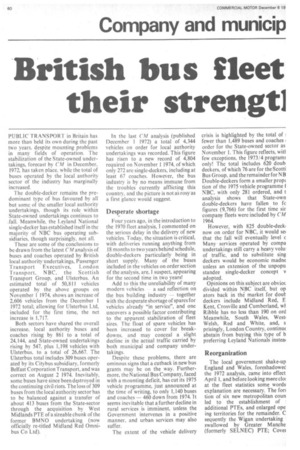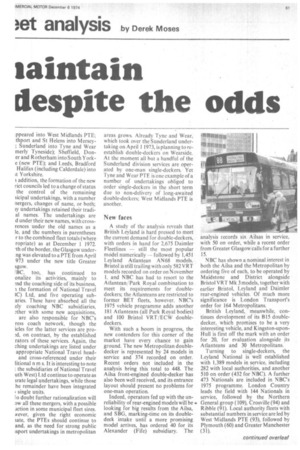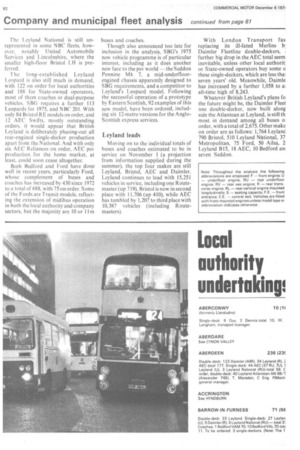British bus fleet taintain their strengtl despite the odds
Page 62

Page 63

Page 64

If you've noticed an error in this article please click here to report it so we can fix it.
PUBLIC TRANSPORT in Britain has more than held its own during the past two years, despite mounting problems in many fields of operation. The stabilization of the State-owned undertakings, forecast by Cl"! in December, 1972, has taken place, while the total of buses operated by the local authority sector of the industry has marginally increased.
The double-decker remains the predominant type of bus favoured by all but some of the smaller local authority undertakings, though its role within State-owned undertakings continues to fall. Meanwhile, the Leyland National single-decker has established itself in the majority of NBC bus operating subsidiaries, though surprisingly, not all.
These are some of the conclusions to be drawn from the latest CM analysis of buses and coaches operated by British local authority undertakings, Passenger Transport Executives, London Transport, NBC, the Scottish Transport Group, and Ulsterbus. An estimated total of 50,811 vehicles operated by the above groups on November I 1974, shows an increase of 2,606 vehicles from the December 1 1972 total; allowing for Ulsterbus Ltd, included for the first time, the net increase is 1,717.
Both sectors have shared the overall increase, local authority buses and coaches rising by 861 to a total of 24,144, and State-owned undertakings rising by 547, plus 1,198 vehicles with Ulsterbus, to a total of 26,667. The Ulsterbus total includes 309 buses operated by its Citybus subsidiary, formerly Belfast Corporation Transport, and was correct on August 2 1974. Inevitably, some buses have since been destroyed in the continuing civil riots. The loss of 309 buses from the local authority sector has to be balanced against a transfer of about 413 buses from the State-sector through the acquisition by West Midlands PTE of a sizeable chunk of the former BM NO undertaking (now officially re-titled Midland Red Omnibus Co Ltd). In the last CM analysis (published December 1 1972) a total of 4,344 vehicles on order for local authority undertakings was recorded. This figure has risen to a new record of 4,804 required on November 11974, of which only 272 are single-deckers, including at least 67 coaches. However, the bus industry is by no means immune from the troubles currently afflicting this country, and the picture is not ak rosy as a first glance would suggest.
Desperate shortage
Four years ago, in the introduction to the 1970 fleet analysis, I commented on the serious delay in the delivery of new vehicles. Today, the situation is critical, with deliveries running anything from 18 months to two years behind schedule, double-deckers particularly being in short supply. Many of the buses included in the vehicles on order section of the analysis, are, I suspect, appearing for the second time in two years!
Add to this the unreliability of many modern vehicles a sad reflection on the bus building industry — together with the desperate shortage of spares for vehicles already "in service", and one uncovers a possible factor contributing to the apparent stabilization of fleet sizes. The float of spare vehicles has been increased to cover for breakdowns, and may conceal a slight decline in the actual traffic carried by both municipal and company undertakings.
Despite these problems, there are ominous signs that a cutback in new bus grants may be on the way. Furthermore, the National Bus Company, faced with a mounting deficit, has cut its 1975 vehicle programme, just announced at the time of writing, to only 1,140 buses and coaches — 460 down from 1974. It seems inevitable that a further decline in rural services is imminent, unless the Government intervenes in a positive manner, and urban services may also suffer.
The extent of the vehicle delivery crisis is highlighted by the total of i fewer than 1,489 buses and coaches I order for the State-owned sector as November 1. This figure reflects, witl few exceptions, the 1973/4 programr only! The total includes 620 doub deckers, of which 76 are for the Scotti Bus Group, and the remainder for NB Double-deckers form a smaller prop( tion of the 1975 vehicle programme NBC, with only 281 ordered, and t analysis shows that State-own double-deckers have fallen to fa figures (9,766) for the first time sir company fleets were included by CM 1964.
However, with 825 double-decki now on order for NBC, it would se( that the fall will eventually level c Many • services operated by compa undertakings still carry a heavy volui of traffic, and to substitute sing deckers would be economic madne unless an extension of the unpopu standee single-decker concept v adopted.
Opinions on this subject are obviot divided within NBC itself, but op ators back in the market for clout deckers include Midland Red, E Kent, Crosville and Cumberland, wl Ribble has no less than 190 on ord Meanwhile, South Wales, West, Welsh, Red and White, and, s prisingly, London Country, continue abstain from buying this type of b preferring Leyland Nationals instea,
Reorganization
The local government shake-up England and Wales, foreshadowed the 1972 analysis, came into effect April 1, and before looking mere clo: at the fleet statistics some words explanation are necessary. The fon tion of six new metropolitan coun led to the establishment of additional PTEs, and enlarged ope ing territories for the remainder. C sequently the Wigan undertaking swallowed by Greater Man,che (formerly SELNEC) PTE; Covet ppeared into West Midlands PTE; thport and St Helens into Mersey; Sunderland into Tyne and Wear merly Tyneside); Sheffield, Doner and Rotherham into South Yorke (new PTE); and Leeds, Bradford Halifax (including Calderdale) into ct Yorkshire.
addition, the formation of the new rict councils led to a change of status the control of the remaining iicipal undertakings, with a number nergers, changes of name, or both; ty undertakings retained their tradial names. The undertakings are d under their new names, with crossrences under the old names as a le, and the numbers in parentheses r to the combined fleet totals (where ropriate) as at December 1 1972. 'th of the border, the Glasgow underng was elevated to a PTE from April 973 under the new title Greater sgow.
[BC, too, has continued to onalize its activities, mainly to :nd the coaching side of its business, the formation of National Travel IC) Ltd, and five operating subaries. These have absorbed all the ely coaching NBC subsidiaries, !ther with some new acquisitions, are also responsible for NBC's ress coach network, though the icles for the latter services are pro on contract, by the established rators of these services. Again, the ching undertakings are listed under appropriate National Travel head and cross-referenced under their litional n m s. It is interesting to note : the subsidiaries of National Travel uth West) Ltd continue to operate as irate legal undertakings, while those he remainder have been integrated single units.
lo doubt further rationalization will cow all these mergers, with a possible Iction in some municipal fleet sizes. Never, given the right economic late, the PTEs should continue to and, as the need for strong public sport undertakings in metropolitan areas grows. Already Tyne and Wear, which took over the Sunderland undertaking on April 11973, is planning to reestablish double-deckers on Wearsicle. At the moment all but a handful of the Sunderland division services are operated by one-man single-deckers. Yet Tyne and Wear PTE is one example of a nuMber of undertakings obliged to order single-deckers in the short term due to non-delivery of long-awaited double-deckers; West Midlands PTE is another.
New faces
A study of the analysis reveals that British Leyland is hard pressed to meet the current demand for double-deckers, with orders in hand for 2,675 Daimler Fleetlines — still the most popular model numerically — followed by 1,451 Leyland Atlantean AN 68 models. Bristol is still trailing with only 582 VRT models recorded on order on November and NBC has had to resort to the Atlantean /Park Royal combination to meet its requirements for doubledeckers; the Atlanteans are restricted to former BET fleets, however. NBC's 1975 vehicle programme adds another 181 Atlanteans (all Park Royal bodies) and 100 Bristol VRT/ECW doubledeckers.
With such a boom in progress, the new contenders for this corner of the market have every chance to gain ground. The new Metropolitan doubledecker is represented by 24 models in service and 374 recorded on order. Recent orders not included in the analysis bring this total to 448. The Ailsa front-engined double-decker has also been well received, and its entrance layout should present no problems for one-man operation.
Indeed, operators fed up with the unreliability of rear-engined models will be looking for big results from the Ailsa, and SBG, marking-time on its doubledeck intake until a more promising model arrives, has ordered 40 for its Alexander (Fife) subsidiary. The analysis records six Ailsas in service, with 50 on order, while a recent order from Greater Glasgow calls for a further 15.
NBC has shown a nominal interest in both the Ailsa and the Metropolitan by ordering five of each, to be operated by Maidstone and District alongside Bristol VRT Mk 3 models, together with earlier Bristol, Leyland and Daimler rear-engined vehicles. Of much more significance is London Transport's order for 164 Metropolitans.
British Leyland, meanwhile, con tinues development of its B15 doubledecker, which promises to be a very interesting vehicle, and Kingston-uponHull is first off the mark with an order for 20, for evaluation alongside its Atlanteans and 30 Metropolitans.
Turning to single-deckers, the Leyland National is well established with 1,389 models in service, including 282 with local authorities, and another 510 on order (432 for NBC). A further 473 Nationals are included in NBC's 1975 programme. London Country leads the field with 144 Nationals in service, followed by the Northern 4, General group (109), Crosville (94) and Ribble (91). Local authority fleets with substantial numbers in service are led by West 'Midlands PTE (93), followed by Plymouth (60) and Greater Manchester (31). The Leyland National is still unrepresented in some NBC fleets, however, notably United Automobile Services and Lincolnshire, where the smaller high-floor Bristol LH is preferred.
The long-established Leyland Leopard is also still much in demand, with 122 on order for local authorities and 188 for State-owned operators, most of them coaches or dual-purpose vehicles. SBG requires a further 113 Leopards for 1975, and NBC 201. With only 84 Bristol RE models on order, and 12 AEC Swifts, mostly outstanding orders, it would appear that British Leyland is deliberately phasing-out all rear-engined single-decker production apart from the National, And with only six AEC Reliances on order, AFC psv production for the home market, at least, could soon cease altogether.
Both Bedford and Ford have done well in recent years, particularly Ford, whose complement of buses and coaches has increased by 430 since 1972 to a total of 688, with 75 on order. Some of the Fords are Transit models, reflecting the extension of rnidibus operation in both the local authority and company sectors, but the majority are 10 or 11 m buses and coaches.
Though also announced too late for inclusion in the analysis, SBG's 1975 new vehicle programme is of particular interest, including as it does another new face to the psv world — the Seddon Pennine Mk 7, a mid-underfloorengined chassis apparently designed to S BC requirements, and a competitor to Leyland's Leopard model. Following the successful operation of a prototype by Eastern Scottish, 92 examples of this new model, have been ordered, including six 12-metre versions for the AngloScottish express services.
Leyland leads
Moving on to the individual totals of buses and coaches estimated to be in service on November 1 (a projection from information supplied during the summer), the top four makes are still Leyland, Bristol, AEC and Daimler. Leyland continues to lead with 15,251 vehicles in service, including one Routemaster (up 719), Bristol is now in second place with 11,706 (up 410), while AEC has tumbled by 1,207 to third place with 10,387 vehicles (including Routemasters).
With London Transport fas replacing its ill-fated Merlins b: Daimler Fleetline double-deckers, ; further big drop in the AEC total seem inevitable, unless other local authorit; or State-owned operators buy some o
• these single-deckers, which are less thai seven years' old. Meanwhile, Daimle has increased by a further 1,058 to ai all-time high of 8,243.
Whatever British Leyland's plans fo the future might be, the Daimler Fleet line double-decker, now built along side the A tlantean at Leyland, is still th most in demand among all buses oi order, with a total of 2,675. Other make on order are as follows: 1,764 Leyland 790 Bristol, 510 Leyland National, 37. Metropolitan, 75 Ford, 50 Ailsa, 2 Leyland B15, 18 AEC, 10 Bedford am seven Seddon.












































































































































